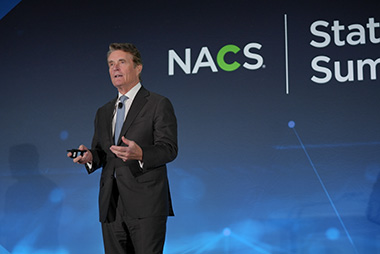 Another successful NACS State of the Industry is in the books, and I’d be remiss not to say it was my last SOI Summit as your NACS president and CEO.
Another successful NACS State of the Industry is in the books, and I’d be remiss not to say it was my last SOI Summit as your NACS president and CEO.
More than 700 retailers and suppliers listened to vast amounts of data and information that can move our businesses and our industry forward. Then it’s my job to wrap up all these learnings and ask, “What does it all mean?”
It’s important to step back and ask this question, and after listening and taking notes on each presentation, six themes stood out. I was also inspired by Steve Lerch’s presentation on the practicality of generative AI tools. To combine my thoughts on these six themes, I dropped my notes into Copilot. The speed is a gamechanger and I mostly agreed with the copy, but it still needed my personal input. So think of AI as a tool, not a replacement.
Onto the six themes from this year’s NACS State of the Industry Summit:
1. Resilience—Our Core Strength
This is not just looking in the rearview mirror to see how we weathered past challenges. Resiliency is a part of your strategy going forward. It's about preparing for the future, and financial strength is a huge piece of that. Building a culture of resilience and also focusing on the core strengths of people is crucial. Think about how you can make your business more resilient by the ways your company can absorb external shocks and take advantage of opportunities.
2. Nimbleness and Agility
We heard a lot about nimbleness and agility throughout the SOI Summit, particularly in the discussions on tariffs and supply chain shifts.
In March during the NACS Convenience Summit Asia in Tokyo, the main concern was tariffs. The consensus was that it's all about money and shifting supply chains, and that we need to design supply chains to be more nimble and agile. This reminded me of the COVID-19 pandemic, when most companies spoke about re-engineering their procurement systems and supply chains to be more agile. Only about 2% of companies actually did so, but those who did are better prepared for the current disruptions.
Many of us in the convenience retail industry have muscle memory from the adjustments made four years ago, which will help us with the uncertainty around tariffs and supply chain shifts.
3. Seizing New Opportunities
As with every SOI Summit, we hear about new and emerging product trends. This year I heard a lot of buzz around cannabis and hemp beverages (no pun intended). No other retail channel can move on these trends as quickly as we can, and we need to be agile and nimble enough to tap into these new opportunities. You also need a culture that allows a quick response to happen.
4. Food and Beverages
We know there’s a decline in cigarette volumes and a lurking decline in fuel volumes. But you have ask yourself what’s going to replace them. A lot of companies are leaning heavily into foodservice, and it’s clear that they are delivering high margin value to their company and driving more foot traffic inside their stores.
Foodservice is a complicated category, and not all companies can excel at a high level, especially with prepared food—and that’s OK.
I will say this again: I don't think we've positioned our industry well enough to highlight our competitive advantages. Those that do food well will continue to do so. These companies are also industry champions for keeping food safety front and center within their company cultures.
But remember that beverages are a significant part of foodservice and a differentiator for our industry. C-stores offer an impressive selection of immediate refreshments, and every convenience store, no matter the size or location, can leverage this. The breadth and depth of our beverage offer is second to none. The number one reason customers visit convenience stores is for immediate refreshment, so keep focusing on this moving forward.
5. Nuts & Bolts of Retail Execution
I recently hosted meetings with CEOs from Latin America, Europe and the U.S., and there’s a common theme they all mentioned that also transpired at the SOI Summit. There's a real need to refocus on executing the basics of retail well. Since the pandemic, the bar for delivering great customer service has been set pretty low. This is unfortunate, but take it as an opportunity. Greet every customer who enters your stores, offer to assist and be the friendly faces who brighten someone’s morning or day.
If we can execute the fundamentals well—clean stores, friendly staff, functioning and reliable equipment—this industry will stand out. Executing the basics well isn't sexy, but it's crucial. People often get distracted by the bright, shiny objects and forget the importance of a quick, clean, easy and hassle-free shopping experience.
6. Your People
Being in this industry for over 50 years, I’ve found that most retailers agree that their most important asset is their people. Yet many companies underinvest in their staff. Instead they shift resources to customer experience, design, and new technologies. The irony of this is that the most important aspect of customer experience is the interactions our store associates have with our customers. Double down on investing in your people, make certain they are well-trained, well-treated, and recognized for their contributions to your company’s success.
At the end of the day, the top-performing companies in the c-store industry have a clear commonality: They focus on their people.
Let’s continue these conversations throughout the rest of the year and I look forward to seeing everyone at the greatest show on earth—the NACS Show—October 14-17 in Chicago.